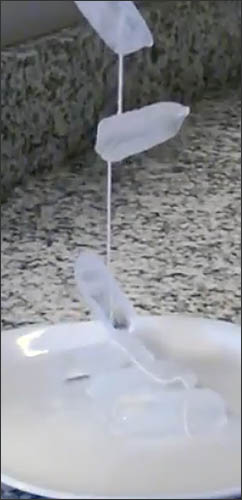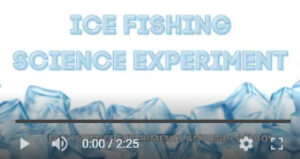Ice Fishing

Materials:
- Small paper cups, bowl or an ice cube tray
- Glass of water
- String (yarn or kite sting works great)
- Small stick
- Salt
Instructions:
- Fill the cup or tray up with water and place it in the freezer. You can also use ice cubes from your freezer and skip this step.
- When the water is frozen, remove the ice from the cup or tray.
- Put the ice in the glass or bowl of water. The cube will bob up and down in the water and then float on the top.
- Place one end of the string from the fishing pole on top of the ice cube and sprinkle salt on the ice where the string is touching. Watch as the water melts slightly and refreezes.
- After about 10 seconds, carefully lift the ice cube out of the water with the fishing pole. You caught a fish (ice)!
Watch Scientist Joe conduct the Ice Fishing Experiment here!
How it Works:
Ordinary water freezes at (32° F). When you add salt to water, it lowers the water’s freezing temperature-it has to get colder than 32° F to freeze.
How much colder depends on how much salt is mixed in with the water. The salt you sprinkle on the ice cube lowers its freezing temperature and, since the ice cube can’t get any colder than it already is, it starts to melt. A little pool of water forms on top of the ice cube and the string sinks into it. As the ice cube melts, it dilutes the salt/water mixture in the little pool; the freezing point starts to go back up again. The ice refreezes, trapping the string. As soon as the ice cube hardens, you can raise it by lifting the string. All this happens very quickly, of course.
WATCH THE QUICK AND EASY VIDEO TUTORIAL
Extra Experiments:
Try sugar, pepper, sand, flour, you name it. See what works, and what doesn’t, and try to figure out why!
EXPLORE TONS OF FUN AND EASY SCIENCE EXPERIMENTS!
SUBSCRIBE AND NEVER MISS A NEW SCIENCE FUN VIDEO!


